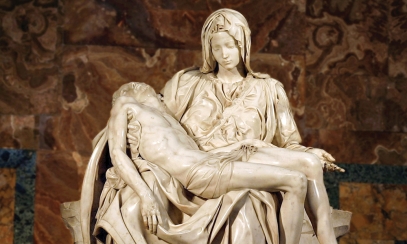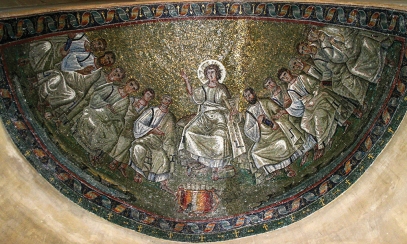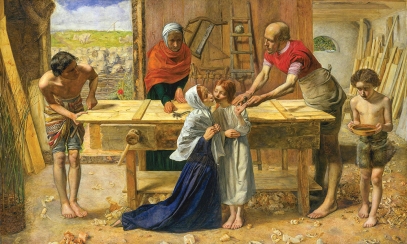
Let’s consider the Holy Family’s journey to Egypt
Today let us combine Lectio Divina and Visio Divina by starting with Scripture and then turning it into art. You will be the director of a film titled The Flight to Egypt. The script is minimal to say the least. “When they [the magi] had departed, behold, the angel of the Lord appeared to Joseph in a dream and said, ‘Rise, take the child and his mother, flee to Egypt and stay there until I tell you. Herod is going to search for the child to destroy him.’ Joseph rose and took the child and his mother by night and departed for Egypt.” (Mt 2:13-14)
Today let us combine Lectio Divina and Visio Divina by starting with Scripture and then turning it into art. You will be the director of a film titled The Flight to Egypt. The script is minimal to say the least. “When they [the magi] had departed, behold, the angel of the Lord appeared to Joseph in a dream and said, ‘Rise, take the child and his mother, flee to Egypt and stay there until I tell you. Herod is going to search for the child to destroy him.’ Joseph rose and took the child and his mother by night and departed for Egypt.” (Mt 2:13-14)
Let us begin with a short meditation: Inhale slowly and deeply, contemplating the idea of a young couple with a newborn walking roughly the distance from Austin to Baton Rouge. Now exhale deeply and slowly, giving up the anachronistic props of modern travel; cell phones, GPS, running shoes, bottled water, restrooms, convenient snacks, disposable diapers, hotels, credit cards, ATMs, ice chests, good and well-marked roads, flashlights, planes or SUVs and their cargo space. Repeat this until you grasp the urgency and desperation of their situation.
Now consider the main characters, giving explicit directions to your casting crew. Mary must be young, with strong character and inner beauty, but who just delivered a child under trying conditions. Be sure the casting crew has someone who knows thoroughly the needs/conditions of a postpartum, nursing body. The baby must be too cute for words, yet able to cry, nurse, sleep and have normal bodily functions. Joseph must be strong, kind, understanding and determined. As for the donkey, you need to decide if it will be obstinate or compliant. Whatever you decide it must be fed, watered, given hourly stops to graze and rest and then cared for at the end of the day.
The plot is simple enough, but there are many twists and subplots to choose from. How will they express the fear, stress and emotions that arise? They leave Bethlehem at night, but will they continue to travel at night? That would mean a slower pace, more chances for injury like twisted ankles and less contact with people means fewer chances to find food and water and get directions, as well as the possibility of inadvertently coming upon soldiers or robbers.
Daytime travel could be quicker (maybe 20 miles a day), less suspicious and perhaps allow them to avoid checkpoints. Will they stay on roads or go cross-country? What is their cover story? (Remember, they can’t lie!) Since there will be many travelers because of the census, should they join a group of travelers for safety and to blend in? Will strangers show kindness, indifference or downright treachery?
You may consider adding health concerns like blisters, dysentery or hemorrhaging to add realism.
The addition of soldiers would be a dramatic element. Perhaps there is a sadistic soldier who catches the family, having already willingly massacred many infants. There could be a young conscript who is sickened by the murders of the innocents and risks his life to let them escape.
The donkey could be comic relief or need to be sold because it is slowing them down or because they need money to continue the trip. Remember, Joseph has marketable skills, but he has none of his tools with him. Maybe they risk delaying their escape from Herod’s reach so that Joseph can find work, earn money to carry on and so they can all rest.
These are just some suggestions. I am sure you will come up with more and better ideas as you contemplate this refugee family and their forced escape. At least we know their faith was strong throughout the ordeal and that can’t help but change their experience. And be comfortable in the knowledge that the script for the sequel, The Return From Egypt, has already been written, see Mt 2:19-23.
Maybe the next time we look at a Christmas card with an image of Mary holding the baby Jesus, sitting on a donkey led by Joseph, we will know it is not a vacation postcard from some exotic location. Let us contemplate with compassion, the Holy Family’s flight to Egypt and those refugees who find themselves in similar circumstances today.
Mark Landers is a parishioner of St. Austin Parish in Austin and a member of the Diocesan Fine Arts Council. He and his wife, Christina, own and operate Landers’ Studio, a woodworking shop and design studio. They design and construct custom furniture and high-quality architectural piecework.



